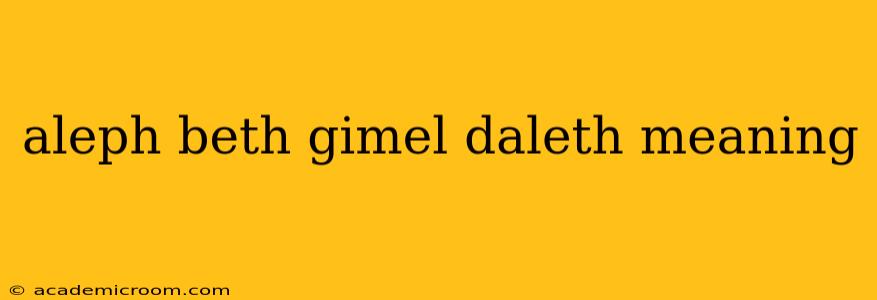The Hebrew alphabet, a cornerstone of Jewish culture and history, holds deep significance beyond its linguistic function. Understanding the meaning behind its initial letters – Aleph (א), Beth (ב), Gimel (ג), and Daleth (ד) – offers a glimpse into the philosophical and spiritual underpinnings of the language itself. This exploration delves into the meanings of these letters, examining their individual symbolism and their collective contribution to the richness of the Hebrew script.
What do the first four letters of the Hebrew alphabet mean?
The first four letters of the Hebrew alphabet, Aleph, Beth, Gimel, and Daleth, don't have single, universally agreed-upon meanings. Their interpretations often vary depending on the context – whether it's Gematria (numerical values), traditional interpretations, or modern linguistic analyses. However, some common and widely accepted interpretations exist:
-
Aleph (א): Often translated as "ox," Aleph represents the beginning, unity, and primal force. Its shape, resembling a head, symbolizes leadership and the origin point. Numerically, it represents "1," emphasizing its foundational role. It also signifies the breath of God, the creative force that brought the world into being.
-
Beth (ב): Meaning "house" or "tent," Beth symbolizes dwelling, shelter, and community. It represents the structure and the framework that supports life. It's a symbol of belonging and security, highlighting the importance of human connection and social bonds.
-
Gimel (ג): Translated as "camel," Gimel signifies grace, kindness, and generosity. The camel's role as a beast of burden and its ability to traverse harsh landscapes represent strength, perseverance, and adaptability. Gimel also symbolizes reward and reciprocity.
-
Daleth (ד): Meaning "door," Daleth signifies transition, change, and opportunity. It represents the passage from one state to another, emphasizing the dynamic nature of life and the importance of embracing new beginnings. It can also symbolize judgment and the need for discernment.
What is the significance of Aleph Beth Gimel Daleth?
The combined significance of Aleph Beth Gimel Daleth goes beyond the individual meanings of each letter. Together, they represent the foundational building blocks of the Hebrew language and, by extension, Jewish thought and culture. They depict the journey from the primal force of creation (Aleph) to the establishment of community (Beth), the rewards of perseverance (Gimel), and the necessity of navigating change (Daleth). This progression highlights a fundamental worldview: a dynamic relationship between the divine and the human, emphasizing both the importance of structure and the inherent fluidity of life.
How are Aleph Beth Gimel Daleth used in Gematria?
In Gematria, a system of assigning numerical values to Hebrew letters, Aleph equals 1, Beth equals 2, Gimel equals 3, and Daleth equals 4. These numerical values are not merely arbitrary but reflect their place within the sequence and their symbolic meanings. This numerical representation allows for deeper interpretations of texts and the exploration of hidden meanings through numerical correspondences. The use of Gematria with these initial letters often appears in Kabbalistic texts and commentaries.
What is the spiritual meaning of Aleph Beth Gimel Daleth?
From a spiritual perspective, Aleph Beth Gimel Daleth can be seen as a representation of the spiritual journey. Aleph signifies the connection to the divine source, Beth embodies the building of a spiritual foundation, Gimel highlights the importance of compassion and service, and Daleth emphasizes the journey of growth and transformation. This interpretation reflects a progressive, dynamic understanding of spirituality, encompassing both the stability of faith and the challenges of personal growth.
Are there different interpretations of Aleph Beth Gimel Daleth?
Yes, interpretations of Aleph Beth Gimel Daleth vary. Different schools of thought and individuals may emphasize particular aspects of these letters’ symbolism. The meaning often depends on the context in which they are used, whether it's a religious, linguistic, or mystical one. The variations reflect the rich tapestry of interpretations within Jewish tradition.
This exploration provides a comprehensive understanding of the meanings associated with Aleph, Beth, Gimel, and Daleth, highlighting their individual and collective significance within the broader context of the Hebrew alphabet and Jewish culture. The multifaceted nature of their interpretations underscores the depth and richness inherent within this ancient language and its enduring spiritual and cultural influence.
